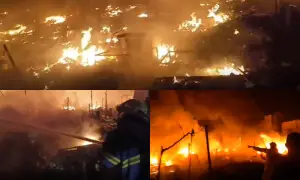Pakistan’s flooded poor people become pucca IDPs
On the edge of Umerkot town in Pakistan’s Thar Desert that borders India, there is a makeshift tent-city for families who fled flooding four months ago during the monsoon. They are among the 33 million people displaced across Pakistan this year. And it is likely the same thing will happen to them next year
A majority of the families have two things in common: they are from a farming background; and they are constant climate migrants since the catastrophic 2010 floods. They are the surest proof that Pakistan is at the top of the list of the world’s countries hit by the climate crisis.
It was a routine practice during the droughts of the Thar Desert for people to migrate towards the river-fed areas. However, this year’s floods in the worst-hit Sindh province caused reverse migration, bringing uprooted families from riverine areas towards the desert. While some of the families have returned to their areas, nearly a hundred of them are still stuck as the water has not receded four months on.
The United Nations recently reported that an estimated eight million people in Pakistan are still potentially exposed to floodwaters or are living close to flooded areas mainly in Sindh.
Fifty-year-old Leema Bheel arrived at a relief camp on the outskirts of Umerkot three and a half months ago along with his family of nine. In the last 13 years this is the third time Leema had to move because of flooding which destroyed his house in Umerkot. This year was no exception.
“I belong to an area which is outside the desert,” he told Aaj News. “This year, due to the rains, I had to take shelter here in the desert along with my family.” They had to travel 50 kilometers (31 miles) to achieve this.
“The last time I migrated was in the 2010 river floods and the 2011 torrential rains. Every time I returned I had to start my life from scratch.”
Another migrant is Fozia Arab who has also taken refuge at the Umerkot camp along with her family from Tando Allahyar district, which is roughly 100 kilometers (62 miles) away.
“Since the 2010 floods I have migrated three times,” she says. “Even after four months, we don’t have a place to live back home. The people who are living here in the camps are those who were inundated and migrated again and again.”
The people at the camp struggle in the tents as winter unfolds. Their children are catching the flu and colds but there are no doctors. At night they keep waking up because of fear of insects.
Women have no privacy as the camp has no toilets. They have to wait for cover of darkness so they can relieve themselves. This issue has been flagged ever since natural disasters started unfolding in Pakistan but the authorities have yet to pivot to more women-friendly relief work.
Perhaps one of the greatest losses is the children’s schooling, which is constantly interrupted due to climate change. This much is certain, without schooling, these children are at a greater risk of being drawn into labour work which will keep them below the poverty line.
Some people have managed to return home, but that has not been easy either.
A few kilometers away from the relief camp, in village Mandal Thakar of Umerkot, agriculture laborer Sajan Meghwar is trying to rebuild his home. He also reports that the rains forced him to migrate with his family for the second time in three years since the 2020 floods. The family returned last week after being uprooted for three months.
“I had to migrate eighty kilometers to the Thar Desert where I would work as a laborer,” he said.
He is now in a hurry to get his house up and running before the cold weather sinks in. As his farm lands are still under water, he has no choice but to work at as a herder.
“Building a house is a difficult exercise – that too again and again. I don’t know how long my new house will last,” he added.
Uprooted peasants who were interviewed collectively linked their frequent homelessness with their landless status. As agriculture laborers, they live on their landlord’s land for a few years before they switch to another landlord. Poverty and frequent job switching do not allow them to build a pucca house made of bricks and cement and ultimately leaves them no choice but to build a katcha mud house. So when heavy rains and floods come they are the first and worst victims to lose their homes.
Leema said that if the government wanted to ensure people like him are not uprooted because of the floods in future, it needs to provide them land and resources to build pacca houses which can face flooding and prevent frequent forced migration. “I appeal to the government to grant us land as well as money to build a pacca house,” he added.
Arab’s demand was no different. “I demand the government allot me land where I can bring up my children with ease and I don’t have to migrate every now and then,” she added.
Sajan said that the government had never compensated him for his lost house.
A fresh survey suggested that Pakistan ranks second in the world with the highest number of homeless people.
Professor Dr. Noman Ahmed, dean at the Faculty of Architecture and Management at NED University of Engineering & Technology Karachi, supports the demand for land to landless people. “With modern technology, cheap flood-resistant houses can be built like raised houses but for this one needs to have land,” he said. “In the past, governments have never initiated any program to provide land to the landless and homeless persons so they can build their own houses.”
He stressed that a mechanism needs to be created to ensure people get a warning in advance for extreme climate events so that social mobilization can take place around sensitive locations. This would reduce the damage.
“I believe that climate change and especially the extended monsoon regime is now going to become a new normal,” he said. “And in order to be prepared for the situation it will be important for us to develop a very carefully designed early warning system for people to be alarmed about the incoming climate change regimes and leave their places to safer locations.”
Economist Dr Kaiser Bengali was in charge of a Sindh government’s initiative for the rehabilitation of the 2010 flood victims. According to him, it is not climate change alone but tampering with climate in the last forty years that has induced migration in Sindh.
“Climate change is causing its devastation but a lot of it is also man-made,” he argues. “If you build a house in the way of the water, that house will be washed away. The question is, why build something that will obstruct the water or play with nature? We cannot fight with nature; we have to live with it.”
Dr Bengali says we need to build houses on higher ground and plinths so that when there is a little bit of water in the village, it doesn’t enter the house. This model was successfully adopted in his construction work in 2010 and was supposed to be a model for the rest of Sindh but it was never taken up.
He suggests fresh mapping of rainwater routes, creating structures that will channelize it, specially the hill torrents from the Kirthar range so that towns and cities, and structures and factories and other installations are protected. He also suggests that the government widen the drainage channels in Sindh. Existing channels are just for irrigation runoff and they don’t have the capacity to take floodwater.
“All obstructions along with the River Indus have to be removed so that the flood water can flow into the sea,” he said. “The Sindh government has already passed a law that all these private structures along with River Indus are illegal - that law should be enforced.”
Zulfiqar Kunbhar is a Karachi-based environment journalist
For the latest news, follow us on Twitter @Aaj_Urdu. We are also on Facebook, Instagram and YouTube.



















Comments are closed on this story.